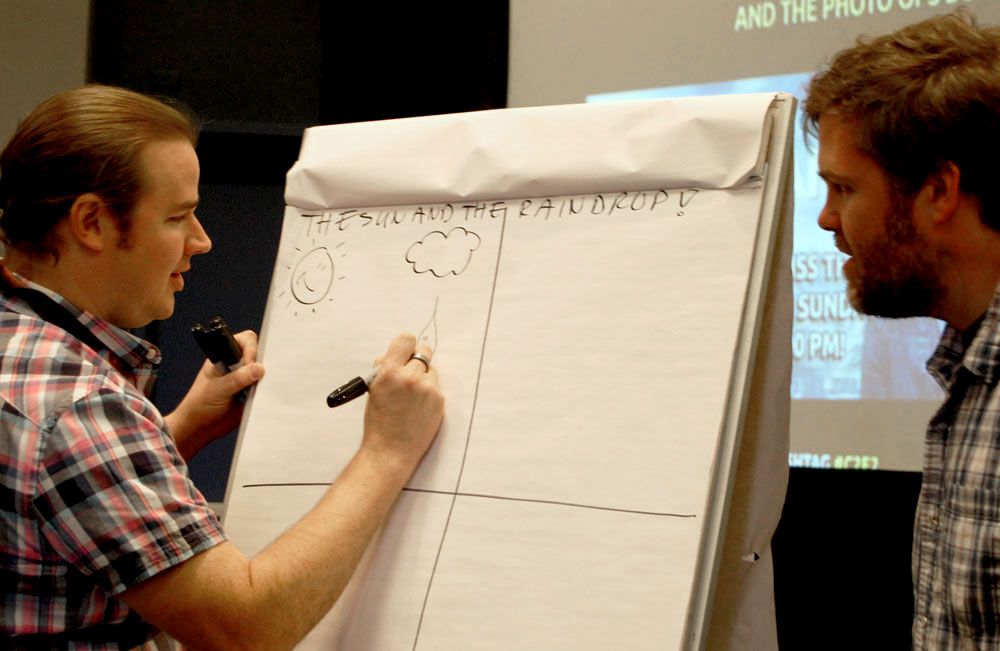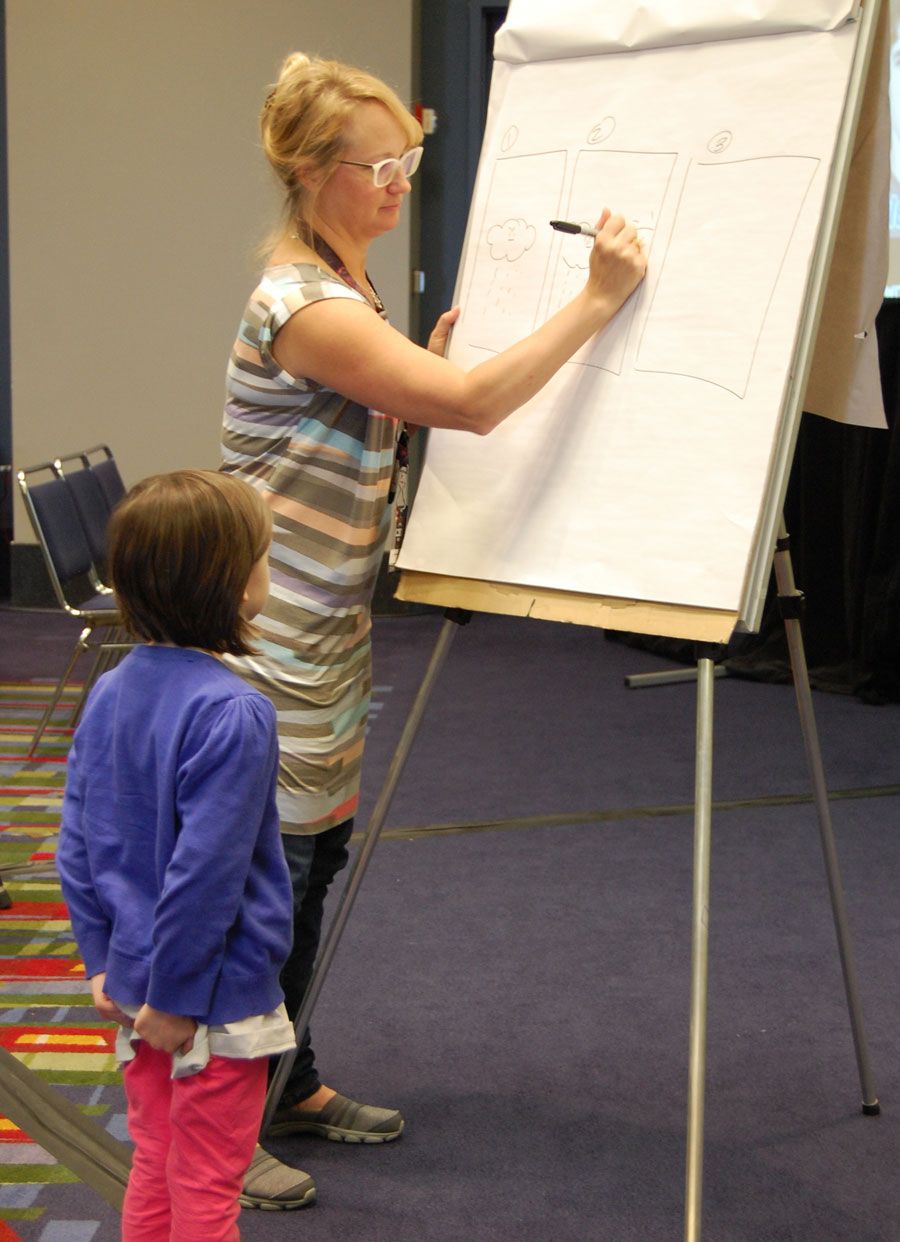The days of hiding your comics inside your schoolbooks are long gone-now comics are the new schoolbooks, according to the panelists in the "Kids Comics Heroes: Raising a Reader" panel at the Chicago Comics and Entertainment Expo.
The panel was moderated by Dr. Meryl Jaffe,instructor for Johns Hopkins University Center for Talented Youth Online Division and the author of "Using Content Area Graphic Texts for Learning: A Guide for Middle-Level Educators." She was joined by the brother-and-sister team of Jennifer and Matthew Holm, who are the creators of "Babymouse" and "Squish"; Jeffrey Brown, author of "Star Wars: Jedi Academy" and "Star Wars: Vader's Little Princess"; Josh Elder, founder of Reading With Pictures, a nonprofit organization that advocates for the use of comics in schools, and writer for DC Comics' "Adventures of Superman" and "Scribblenauts" digital comics; and Alex Cox, a former comics retailer and current deputy director of the Comic Book Legal Defense Fund.
The Holms led off with a description of how comics figured into their childhood. They grew up in a family of five children, with a father who was a big comics fan, and their mother would give them each a bag of comics to keep them quiet on long car rides. "I was reading all those superheroes, like Superman, Spider-Man, and Plastic Man, and I noticed there were not a lot of ladies, back in the old days, the 70s," Jennifer Holm said. "Of course there was Wonder Woman. I didn't really identify with Wonder Woman, I'm not sure why."
"Was it the gold underwear?" asked her brother.
"I was a normal kid and I wore clothes," Jennifer said. "I just wanted a character I could relate to like my brothers related to Peter Parker and Spider-Man. We were both living in New York City at the time I came up with the idea of Babymouse. We sort of came up with it to fulfill this empty space in the market."
Elder learned to read from comics; his mother used to read to him at bedtime, and he always asked for comics. Then, in the middle of issue #4 of "Transformers," disaster struck: "Halfway through reading it Mom lost her voice and couldn't finish the story." Elder recalled. "This was completely unacceptable. It's outrageous! Optimus Prime was in a lot of danger, and I had to make sure he was OK, and with mom out of the picture, I had no choice but to finish this story myself. So I used the comic to teach myself how to read the comic. I used the images to bootstrap me up through the narrative, and I'd bother Mom to define words I didn't already know. It took about two weeks for me to do it, but I read the comic on my own, and then I started reading everything on my own." Elder went on to read far beyond his grade level in school. "'Hooked on Comics' worked for me, and that's why Reading With Pictures exists," he said. "I know from my own life that this works, that there is an extraordinary tool if we just utilize it properly."
Not everyone sees it that, way, and Jaffe admits she herself was a skeptic: "I was a parent who said 'Don't even think about bringing that stuff home,' and I was a teacher who said 'Uh-uh, not in my classroom,' but luckily my kids did an intervention," she said. "I saw the light."
Librarians are often the biggest advocates for graphic novels, Matthew Holm said, because the school librarian is one of the few people who sees a student every week, year after year, so they see children who haven't been interested in reading get enthusiastic about comics. Many teachers have come on board as well, for similar reasons. " We started to hear from kids when we do school visits, they are like, 'Wow, I could finish that whole book,' which isn't anything that I ever thought would be important to kids, but it is important to them to feel like they have achieved something," he said. "Some kids will check out library books and never finish them and return them. Even though it's 100 pages, they can get through the entire book themselves and feel like they have accomplished something."
Matthew Holm also spoke of a teacher who had a fourth-grade student who had multiple learning disabilities but was able to read his books. "She was in fourth grade, and when you are in fourth grade you don't want to be reading a kindergarten picture book, even if that's what your reading level is," he said. "One of the interesting things with comics a lot of times the vocabulary is a lot higher than what their reading level is supposed to be. And you look cool reading comics."
Elder has traveled to Belarus and Chile to persuade educators there to include comics in the classroom, an idea that is much more of a novelty there than in the U.S. "I used the Ikea example," he said. "How does Ikea teach people to perform a process? They use a diagram -- it's a comic... One of the slides I love to put up there is the instruction thing in the seat back in a plane. Comics can save your life. In the most high stakes situation imaginable, where you will die if you don't learn how to do this thing right and do it right now, we always turn to comics. If it's good enough for that, then why isn't it good enough to teach literally everything else?"
Jaffe ticked off a list of ways in which graphic novels help students acquire new skills, in addition to simply reading. "They also help kids develop critical thinking and inference, because in graphic novels, you have to pair the text with the image, and they are not the same," she said. "They are different to build the story, and you the reader have to construct the story, and that takes a lot of critical thinking and inference skills. Also sequencing, it teachers kids how to better sequence, first-next-last, because whether you are reading them or you are creating them, you have to know the flow of the page and the story. It also helps with memory, because it pairs visual and verbal text, so you are making more memory connections, and it also helps with attention."
Even children who can't read words yet can read a comic, Jennifer Holm said, demonstrating with the help of a young girl named Mackenzie. Stepping down from the stage to a pad of paper set up on a nearby easel, Holm drew a three-panel comic about a grumpy cloud who is cheered up by the sun. As the cartoonist drew each image, Mackenzie described what it meant. "You just read a story without any words," Holm said at the end of the exercise. "You should be so proud of yourself!"
Stories without any pictures are another matter, however. Elder discussed image recognition and language acquisition, pointing out that young children do well with both. "But then, at some point we arbitrarily decide, 'Well, now we have to get rid of pictures. Now it's time for serious reading,'" he said. "You can put it on a graph and you can almost see it, fourth grade, seventh grade, when the big drop-offs start to happen in literacy, and I think a big part of it is that is when images start disappearing from all their educational materials."
In fact, visual literacy is more important than ever, Matthew Holm pointed out. "Almost everyone I know who is out in the business world has to put together a PowerPoint presentation," he said. "Even if you are not trained as a graphic designer, you are going to have to act as a graphic designer when you get out there, so you might as well be familiar with how graphics and text interact."
Elder pointed out that visuals are also a more efficient way to convey information. When he visits classrooms, he puts up a comic strip telling a simple story on a screen alongside a paragraph of text describing the same story. He has half the class read one side and half the class read the other, raising their hands when they are doing. "It's almost like in an instant, everyone who is reading the comic strip is done," he said. "They get it. They have got the information, it's there, and now it's in here. It takes 20 to 25 seconds to do the same process, essentially, with text alone. There is literally more information all the time, and if we don't become more efficient in our method of information ingestion, we will fall behind."


